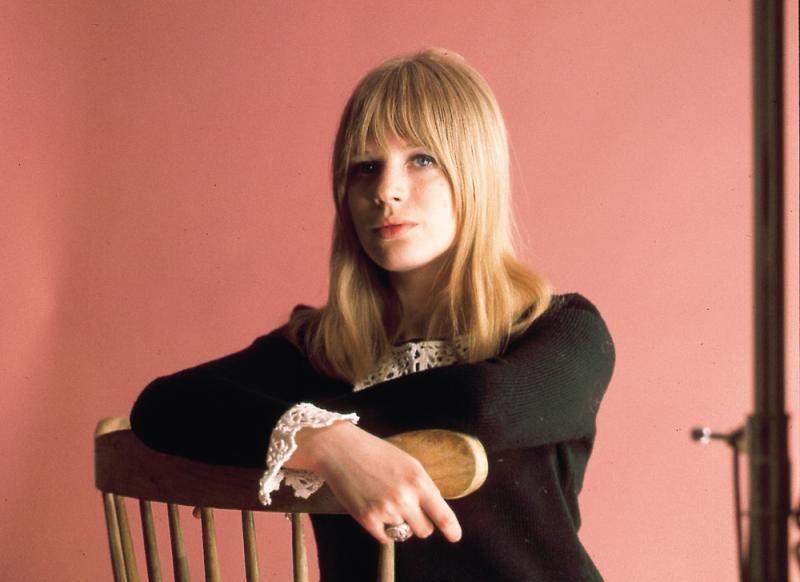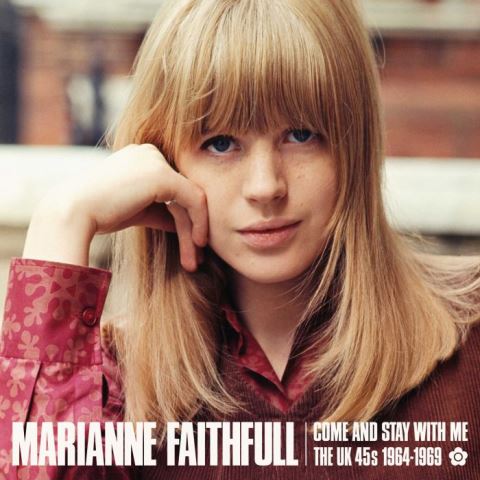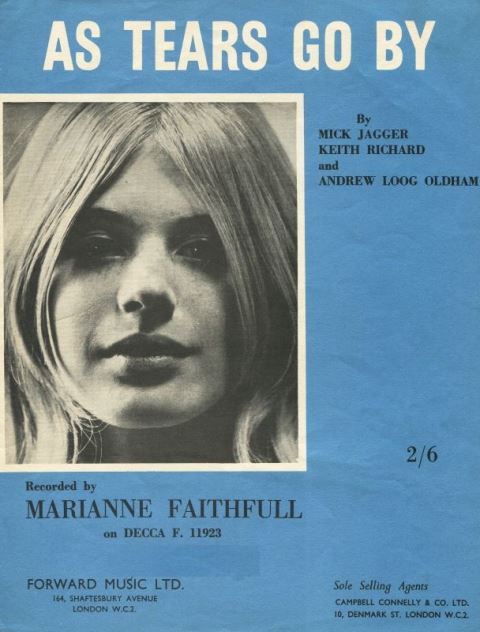Reissue CDs Weekly: Marianne Faithfull | reviews, news & interviews
Reissue CDs Weekly: Marianne Faithfull
Reissue CDs Weekly: Marianne Faithfull
'Come and Stay with Me - The UK 45s 1964-1969' collects some of British pop’s best singles

Marianne Faithfull’s recent album Negative Capability featured a new version of “As Tears go by”, the Jagger-Richard song which had been her first single. Also heard was an adaptation of Dylan’s “It’s All Over Now, Baby Blue”. The A-side of her second single was a cover of his “Blowin’ in the Wind”.
The new, descriptively titled compilation Come and Stay with Me - The UK 45s 1964-1969 collects the A- and B-sides of the 11 singles she issued on Decca in the Sixties and supplements them with the three non-single tracks from her 1965 Go Away From my World EP. In this period she also released four Decca albums with the last, Love In a Mist, going on sale in March 1967. A month earlier, her 10th single “Is This What I Get For Loving You?” had been released. Its follow-up, “Something Better”/ “Sister Morphine” came out in February 1969. In essence, her Decca era ran from the release of “As Tears go by” in June 1964 to March 1967. The final Decca single was an outlier.
 For Kris Needs though, who has written the collection’s very personal liner notes, the “Something Better”/ “Sister Morphine” single is pivotal. As a Rolling Stones fan – and the editor of Zigzag magazine – he bought a copy of the rare 45 in 1979 for £15, a third of his weekly wage. He purchased it at Soho’s Rock On stall, run by the people behind Chiswick Records the precursor of Ace, the label which has issued Come and Stay With me – circularity of another sort.
For Kris Needs though, who has written the collection’s very personal liner notes, the “Something Better”/ “Sister Morphine” single is pivotal. As a Rolling Stones fan – and the editor of Zigzag magazine – he bought a copy of the rare 45 in 1979 for £15, a third of his weekly wage. He purchased it at Soho’s Rock On stall, run by the people behind Chiswick Records the precursor of Ace, the label which has issued Come and Stay With me – circularity of another sort.
Needs was moved to dig deep by “Sister Morphine”. He knew the Stones’ version from Sticky Fingers but had not heard the original recording which was credited to Jagger-Faithfull-Richards. On their album, the Stones noted the songwriters as Jagger-Richard. Of her version, Needs now says it was “harrowingly claustrophobic but starkly direct, no song had ever gouged so deeply into the drug addict’s tormented psyche.” Then he asks the question “what on earth could have happened to the angelic-sounding popstrel whose exquisite sequence of singles after ‘As Tears go by’ seemed to embody the ephemeral era in which they were produced?”
As is now known, the short answer is that Faithfull had begun embodying the spirit of an ensuing era and that the 1969 recording was symptomatic of her own tormented psyche. However, despite her newly, huskily deep voice on February 1967’s magnificent “Is This What I Get For Loving You?”, it is hard to detect how she had reached this point by listening to the preceding sequence of singles. Instead, what is heard and is noticeable from the credits is a push and pull, and an allied burgeoning self-assertion.
 While “As Tears go by” was conceived as and became an Anglo analogue of Françoise Hardy “Blown’ in the Wind”, which she chose as its follow-up top side, was drab and weedy – an unworthy successor. Its B-side was a thin version of “House of the Rising Sun”, also pulled from a Dylan album. Two singles in and inspiration from Faithfull and her producer, Rolling Stones’ manager Andrew Loog Oldham, seemed lacking. It was – until “Is This What I Get For Loving You?” – the last single they made together. Depending on who is telling the story, the break came because she could no longer deal with his unpredictable speed-freak persona or that, from his perspective, he no longer wanted to work with her – his discovery – as she was too safe. In future, her records were mostly arranged and produced by Mike Leander and Oldham’s business partner Tony Calder.
While “As Tears go by” was conceived as and became an Anglo analogue of Françoise Hardy “Blown’ in the Wind”, which she chose as its follow-up top side, was drab and weedy – an unworthy successor. Its B-side was a thin version of “House of the Rising Sun”, also pulled from a Dylan album. Two singles in and inspiration from Faithfull and her producer, Rolling Stones’ manager Andrew Loog Oldham, seemed lacking. It was – until “Is This What I Get For Loving You?” – the last single they made together. Depending on who is telling the story, the break came because she could no longer deal with his unpredictable speed-freak persona or that, from his perspective, he no longer wanted to work with her – his discovery – as she was too safe. In future, her records were mostly arranged and produced by Mike Leander and Oldham’s business partner Tony Calder.
After the “Blown’ in the Wind” hiccup, there was gem after gem. The 1965 A-side “This Little Bird” is a treat. So is the specially penned Jackie DeShannon song “Come and Stay With me”. The 1966 version of Bob Lind’s “Counting” is an atmospheric marvel. However, the immediately earlier single of The Beatles’ “Yesterday” is prissy and another dud. The self-assertion becomes evident from 1965 when Faithfull’s own songs began cropping on B-sides. Of these, 1966’s “I’d Like to Dial Your Number” is a highlight. Faithfull was finding her own voice and her own path.
Come and Stay With me uses new re-masters and is all mono as per the original single masters. It is a diligent release. However, a question remains unaddressed – what has happened to the Lionel Bart song “I Don’t Know How”. Recorded as her debut single, it was shelved in favour of “As Tears go by”. Also, it would have been great for the narrative to have been expanded by including Faithfull’s contemporaneous French- and Italian-language 45s, which were not limited to re-recordings of the UK tracks for non-Anglophone markets. There are exclusive songs like Serge Gainsbourg’s “Hier ou Demain”. Perhaps this a story for another time.
Imponderables aside, the excellent, smartly packaged Come and Stay with Me - The UK 45s 1964-1969 shows how Marianne Faithfull got to where she is today. And, it should not be forgotten that she made some of British pop’s best singles.
- Next week: Kreaturen der Nacht - eye-opening collection of German post-punk
Explore topics
Share this article
The future of Arts Journalism
You can stop theartsdesk.com closing!
We urgently need financing to survive. Our fundraising drive has thus far raised £49,000 but we need to reach £100,000 or we will be forced to close. Please contribute here: https://gofund.me/c3f6033d
And if you can forward this information to anyone who might assist, we’d be grateful.

Subscribe to theartsdesk.com
Thank you for continuing to read our work on theartsdesk.com. For unlimited access to every article in its entirety, including our archive of more than 15,000 pieces, we're asking for £5 per month or £40 per year. We feel it's a very good deal, and hope you do too.
To take a subscription now simply click here.
And if you're looking for that extra gift for a friend or family member, why not treat them to a theartsdesk.com gift subscription?
more
 'We are bowled over!' Thank you for your messages of love and support
Much-appreciated words of commendation from readers and the cultural community
'We are bowled over!' Thank you for your messages of love and support
Much-appreciated words of commendation from readers and the cultural community
 Coldwater, ITV1 review - horror and black comedy in the Highlands
Superb cast lights up David Ireland's cunning thriller
Coldwater, ITV1 review - horror and black comedy in the Highlands
Superb cast lights up David Ireland's cunning thriller
 Kerry Godliman, G-Live review - she's livid but delivers the laughs
Perimenopause provides rich seam of gags
Kerry Godliman, G-Live review - she's livid but delivers the laughs
Perimenopause provides rich seam of gags
 Mark Hussey: Mrs Dalloway - Biography of a Novel review - echoes across crises
On the centenary of the work's publication an insightful book shows its prescience
Mark Hussey: Mrs Dalloway - Biography of a Novel review - echoes across crises
On the centenary of the work's publication an insightful book shows its prescience
 Jansen, LSO, Pappano, Barbican review - profound and bracing emotional workouts
Great soloist, conductor and orchestra take Britten and Shostakovich to the edge
Jansen, LSO, Pappano, Barbican review - profound and bracing emotional workouts
Great soloist, conductor and orchestra take Britten and Shostakovich to the edge
 The Weir, Harold Pinter Theatre review - evasive fantasy, bleak truth and possible community
Three outstanding performances in Conor McPherson’s atmospheric five-hander
The Weir, Harold Pinter Theatre review - evasive fantasy, bleak truth and possible community
Three outstanding performances in Conor McPherson’s atmospheric five-hander
 Jakub Hrůša and Friends in Concert, Royal Opera review - fleshcreep in two uneven halves
Bartók kept short, and a sprawling Dvořák choral ballad done as well as it could be
Jakub Hrůša and Friends in Concert, Royal Opera review - fleshcreep in two uneven halves
Bartók kept short, and a sprawling Dvořák choral ballad done as well as it could be
 Hadelich, BBC Philharmonic, Storgårds, Bridgewater Hall, Manchester review - youth, fate and pain
Prokofiev in the hands of a fine violinist has surely never sounded better
Hadelich, BBC Philharmonic, Storgårds, Bridgewater Hall, Manchester review - youth, fate and pain
Prokofiev in the hands of a fine violinist has surely never sounded better
 Album: Mulatu Astatke - Mulatu Plays Mulatu
An album full of life, coinciding with a 'farewell tour'
Album: Mulatu Astatke - Mulatu Plays Mulatu
An album full of life, coinciding with a 'farewell tour'
 Music Reissues Weekly: Sly and the Family Stone - The First Family: Live At Winchester Cathedral 1967
Must-have, first-ever release of the earliest document of the legendary soul outfit
Music Reissues Weekly: Sly and the Family Stone - The First Family: Live At Winchester Cathedral 1967
Must-have, first-ever release of the earliest document of the legendary soul outfit
 Monteverdi Choir, ORR, Heras-Casado, St Martin-in-the-Fields review - flames of joy and sorrow
First-rate soloists, choir and orchestra unite in a blazing Mozart Requiem
Monteverdi Choir, ORR, Heras-Casado, St Martin-in-the-Fields review - flames of joy and sorrow
First-rate soloists, choir and orchestra unite in a blazing Mozart Requiem
 Dracula, Lyric Hammersmith review - hit-and-miss recasting of the familiar story as feminist diatribe
Morgan Lloyd Malcolm's version puts Mina Harkness centre-stage
Dracula, Lyric Hammersmith review - hit-and-miss recasting of the familiar story as feminist diatribe
Morgan Lloyd Malcolm's version puts Mina Harkness centre-stage

Add comment